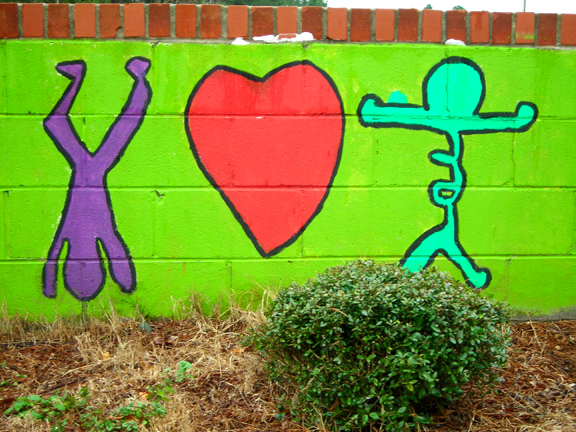
Categories
- Curriculum: Art, Community Service
- Age/Grade: Elementary 2, Elementary 3, Middle School
- Subject: Drawing, Exhibition, Painting
- Materials: Paint, Pencils
- Institution: Rosemont Elementary School
- Location: LaGrange, Georgia
- Duration: 5 - 7 Classes
Description
5th grade students participated in a mural making activity based on the art of Keith Haring. The mural was presented to Rosemont Elementary School as a "thank you" gift for everyone at the school who as helped the 5th grade students.
Objective
To create an outdoor mural based on the art of Keith Haring.
To learn and study the life and art of Keith Haring.
To participate in a cooperative art activity on the campus of Rosemont Elementary School.
(This project can be adapted to fit the needs of any elementary school)
Resources
Haring's book titled "I Wish I Didn't Have to Sleep!
haringkids.com and Haring.com
Anderson, T., & Milbrandt, M. K. (2002). Art for life: Authentic instruction in art. New York: McGraw
Hill.Tuckman, B. W. (1999). Conducting educational research. New York: Wadsworth.
Materials
Outdoor paint
[haringkids.com suggests an adult also apply a top coat or two of Polyurethane or other exterior sealant]
Paintbrushes
Work shirts
Buckets for water
Pencils
Paper for sketching figures
Color pencils for sketches of the figures
A positive attitude for each student and the art teacher
Procedure
INTRODUCTION
From 1997 to 2004, I taught elementary art at Rosemont Elementary School in LaGrange, Georgia. Every year, the 5th grade students left an art gift to the school as a way to say thank you for their education. In 2003, the 5th grade students created an outdoor mural based on Keith Haring's art.
Currently, I am an Ed. D student in the field of art education. I conducted a pilot study with the students, teachers, parents, and the student teacher that helped in this project. The results showed everyone involved in the project that it was meaningful and was a good example of a cooperative art project.
By adding this study to the Keith Haring lesson plan site, it may help an art teacher who would like to gain support form parents, school administrators, and the community before attempting an outdoor mural project based on Keith Haring's art.
1. Teach the 5th grade students about leaving a gift to Rosemont Elementary School. On the board, make a list of everyone who has helped them in school.
2. Introduce students to the life and work of Keih Haring
3. Using white drawing paper and pencils: students will sketch figures and shapes in the style of Keith Haring. Next add color the figures and shapes using color pencils.
4. Discuss the mural with the students. All 5th grade students will vote on the colors of paint to be used. Students will work in groups of 3 to 5 students to sketch figures and images on the outdoor mural wall. The mural is located in the Stancil Memorial Garden on the campus of Rosemont Elementary School in LaGrange, Georgia.
5. Once the figures are on the wall, add paint to each figure.
6. Paint the background of the mural.
7, Outline the figures on the mural, in the style of Keith Haring.
8. Present the mural to the school at the 5th grade graduation. Parents, teachers, administrators, and the community are invited to view the mural. Let LaGrange, Georgia know about Keith Haring!
RESULTS
The questions which guided the study included a variety of ideas relating to the Keith Haring mural and cooperative learning. Overall, the results from the questionnaires found the mural making project to be educational and meaningful. One hundred percent of the students and teachers said they would participate in another mural project and/or a cooperative art project. Twenty-three percent of students responded they had participated in other mural projects, which included a Girl Scout mural, one at a church, and at another school. These positive responses reflected the idea that the teachers and students valued the mural project and cooperative learning in an elementary school. One teacher added the comment, "The students valued the idea of making something more beautiful."
The results indicated students remembered different aspects of the Keith Haring mural project. Eighteen students remembered painting the mural, thirteen remembered drawing the figures outside on the mural wall, while twelve remembered sketching the figures for the mural. Nine students remembered the art lesson about the life of Keith Haring and three added additional comments. Those individual comments included, "Spilling paint and having a great time with my friends." One student wrote, "I am not a great artist, but I could draw pictures like him [Keith Haring]." Thirty-three percent of the students had recognized Keith Haring's art at other locations. They viewed his art at another elementary school, on calendars, and on a card. The responses reflected that Keith Haring was part of the visual culture of the students.
The Teacher grouped students together with different learning levels in art. She pointed out it is necessary based on class size, "I cannot teach thirty-two different ways for thirty-two students I have, so I get them to use each other if they do not understand the way I delivered the information." When asked if she has attempted a mural with her students, she spoke of one being commissioned by her school's administration for the school's new weight room. "Therefore, it is just a matter of time, maybe at the end of the year, as an 8th grade gift." The idea of an eighth grade gift was developed from her student teaching experience during the Keith Haring mural.
According to the results, parents and teachers believed there was educational value in a group project, such as the mural, as opposed to an individual project. These findings are important because they validated the project. Both the parents and teachers recognized that cooperative learning was an important element in the students education. The results were especially interesting because after the mural was completed, the students did not have an individual art project to show their parents. Many art teachers feel pressured to teach art lessons which include a large number of individual art projects for students to take home. The success of the group project was shared by all the students involved.
IMPLICATIONS & RECOMMENDATIONS FOR ART TEACHERS
The results of the pilot study provided information that could lead to a number of implications and recommendations for art teachers. Parents, teachers, administrators, and students valued the cooperative art project and the idea of leaving the mural as a gift to the school. Years after the project occurred, students, parents, teachers, and administrators remembered specific aspects of the project. With their support, this type of art project could be a successful and meaningful addition to an elementary art teacher's curriculum.
The involvement of a student teacher will strengthen the project. An additional teacher can help in the supervision of students. The experience of of being involved with a cooperative art project can help the student teacher strengthen his or her ability to organize any future cooperative art projects. In addition, the student teacher can gain first hand knowledge about cooperative learning in a real classroom setting. This knowledge can be used in the student teacher's future classroom.
The favorable results of this study could be presented to school administrators or school board members before attempting this type of project. This could lead to support and funding for a similar collaborative art project. By including school administrators and school board members in the project, it will extend the idea of cooperation beyond the art teacher's classroom.
Several recommendations concerning cooperative art projects were made by parents and teachers. Their recommendations can help art teachers who want to include cooperative art projects in their curriculum. The recommendations are practical and relate to a public school setting.
When attempting a cooperative art project in an elementary school, the art teacher should get input about the project from others, including school council members, school administration, students, parents, and teachers. As they give their input, the budget and location of the project should be discussed with them. The location and the budget must be agreed upon prior to the start of the project. It is important to remember that even after the project has been agreed upon school administrators need to have the final say in the plan.
By including student input in the cooperative project, they will view the project as being meaningful, and will have more ownership in the project. Encouraging their input will help students "buy-in" to the project and feel responsible for its outcome. The students can either vote on the project they like best or have a committee of students look at all the ideas and pick the one that is most feasible. At the beginning of the project, the students can be organized into groups and assigned certain responsibilities for the project, or they can be allowed to sign-up for the assignment they would like. Many of the projects involve painting, drawing, or other studio assignments and by allowing the students to sign-up for an assignment, they will be comfortable with their task in the project.
Student ownership in the project will be strengthened if each one can sign his or her part of the design. When the project is completed, a plaque or a sign that explains the project would benefit viewers. It will also validate the art education that was taught during the cooperative project and provide recognition for the students who participated.
One administrator recommended the cooperative art project could be taught in conjunction with a lesson on school pride. She pointed out the lesson is especially appropriate for helping students realize the pleasure that comes from giving back with a gift of themselves to the school. The concept of school pride will help with positive student behavior and generate respect from parents, teachers, and students. By relating the cooperative art project to school pride, the school's environment will be enriched.
Another teacher recommended including parents in the cooperative art project. If possible, a Saturday could be designated when students and parents would be able to work on the project together. This would be a great way for parents and students to experience a cooperative art project. The students and their parents would be proud of the gift for many years to come.
One teacher recommended that cooperative art projects should occur only after students take standardized tests. She believed a project occurring before or during testing weeks could distract students from doing their best on the test. On the other hand, students reported wanting to attend school on the days they participated in the mural project. Developing a cooperative art project during the week of standardized tests may lead to a lower student absenteeism.
A structured daily schedule for working on the project will ensure completion. In order for the Keith Haring mural to be completed in a timely manner, students worked continually. The students left their regular classes and worked for forty-five minutes. The students rotated in groups to the outdoor mural and knew there was a timed schedule.
Questions
If your parents walked into the school, what would you tell them about Keith Haring?
Name your favorite part of the mural making activity?
Why is it important to take pride in your art?
Extensions
The 5th grades students can write a letter and design an invitation for their parents to view the Keith Haring mural. This can be done in their homeroom class.




